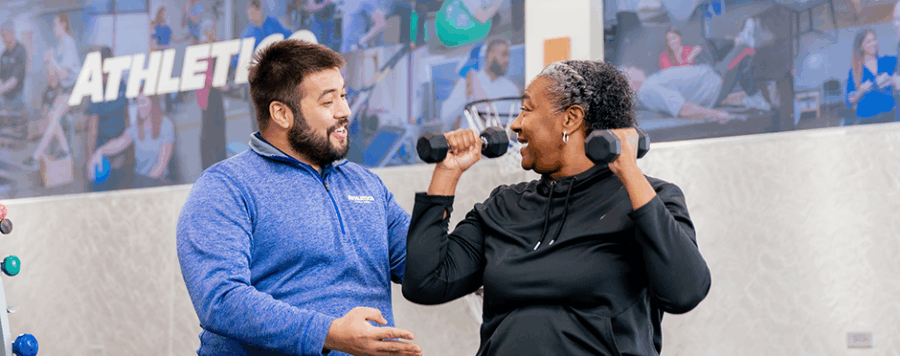6:30 AM – Arrival at the clinic: It is crucial to arrive at the clinic before patient care begins. This time allows for adequate preparation, such as reviewing patient notes and ensuring all necessary equipment and technology are ready. Starting the day organized gets the day off on the right foot and rolling in the right direction.
7:00 AM – First patient of the day: When the first patient arrives, our staff greets them by name, and then their PT starts the session. At the beginning of the treatment session, the PT will discuss any new information the patient provides about their diagnosis or changes that occurred since their previous treatment session. Typical treatment sessions include:
- Manual therapy (hands-on treatment)
- Therapeutic exercises
- Functional activities (navigating stairs or getting up from a chair)
- Neuromuscular re-education (re-training muscles how to work).
7:00 AM – 12:00 PM – Patient care: Patients arrive every 30 minutes, with each treatment typically lasting 60-75 minutes. The PT must coordinate and plan effectively to ensure smooth transitions between overlapping sessions. Skilled therapists and support staff make this flow possible. During sessions, PTs also document the treatment details—how the patient feels, what exercises were performed, their tolerance, and future intentions for a patient’s plan of care.
12:00 PM – 1:00 PM – Lunch/documentation: How therapists use this hour varies—some prefer to eat first, then document, while others might do both simultaneously. It’s also a good time to review upcoming patients or make necessary calls to physicians. Effective use of this time is essential to a smooth-flowing afternoon.
1:00 PM – 3:30 PM – Afternoon patient care: The afternoon sessions mirror the morning, though it’s a shorter block of time, with the same focus on delivering high-quality care.
3:30 PM – 3:45 PM – Final patient departs: The treatment day ends, and it’s time to wrap up any remaining tasks around the clinic.
3:45 PM – 4:00 PM – Finish documentation and head home: Efficient documentation skills are honed over time. Initially, completing all documentation by the end of the day can be challenging without taking work home. However, as therapists refine their daily routine and patient care flow, timely completion becomes easier.
4:00 PM – 10:00 PM – Personal time: Just like everyone else, PTs unwind with activities like working out, spending time with family, having dinner, or watching Netflix. They’re people too!
Of course, no day is exactly the same, but the above timeline provides a realistic breakdown of a typical day in the life of a physical therapist. Are you considering a career in physical therapy? Reach out to our talented team to learn more about our best-in-class benefits, like our Student Loan Repayment and Clinician Mentorship Programs!
The Athletico blog is an educational resource written by Athletico employees. Athletico bloggers are licensed professionals who abide by the code of ethics outlined by their respective professional associations. The content published in blog posts represents the opinion of the individual author based on their expertise and experience. The content provided in this blog is for informational purposes only, does not constitute medical advice and should not be relied on for making personal health decisions.
Brandon Bowers is a doctor of physical therapy and clinic manager at our Cincinnati - Oakley clinic location. He has a passion for treating patients with shoulder injuries and individuals all across the age spectrum. Brandon utilizes blood flow restriction and Astym on a regular basis to help patients get back to living their lives pain free. During the fall he contributes to the Athletico blog as a fantasy football injury expert and has previously spent time in the same role with CBS Sports.

 width="900"
height="356"
>
width="900"
height="356"
>
